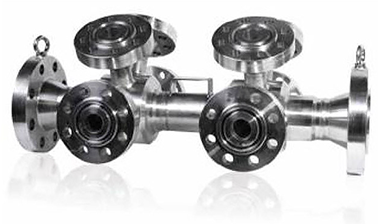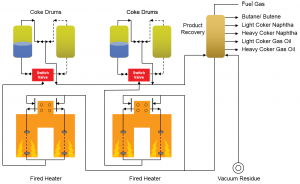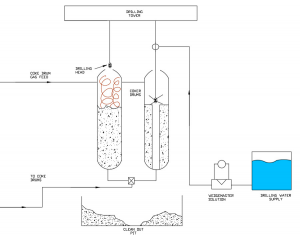
Time tested wedgemeters simplify flow measurement in coker applications
Mike Edwards
Features ABB flow measurement Figure 1: Quadruple tapped wedgemeter.
Figure 1: Quadruple tapped wedgemeter. The wedgemeter has endured the test of time. Since the 1950s, it has proven to be the solution to the most challenging of applications. This is most evident in various refinery processes including the delayed cokers.
Flow measurement of high temperature and high-pressure processes present challenges to the ability and integrity of the overall system to ensure that economic returns are met. In the case of delayed coker processes, maintaining redundant safety and avoiding downtime are the most critical considerations when choosing a flowmeter.
The Delayed Coker System
Delayed coking, the thermal cracking process used by petroleum refineries to further break down of bottoms and vacuum distillates after crude oil has been processed. This process employs furnaces, transfer lines, coking drums and ancillary transportation lines that must be operated on a continuous basis to meet production demands. As fluids move through the process, measurement points become more demanding and require incrementally higher pressures and temperatures. Figure 2 below models the typical delayed coker processes found after atmospheric and vacuum distillation which yields gasoline and diesel fuels as well as other light distillates. In most cases, the processes are duplicated to facilitate routing cleanup of one drum while the other continues the distillation process. Details of coking processes can vary but principles remain the same when considering the fluid measurement of hot, viscous, abrasive fluids. Wedge meters and ancillary equipment must perform within strict boundary requirements while withstanding the aggressive nature of these processes.
The FPD470 Wedgemeter from ABB stands apart from other devices by virtue of providing true DP flow measurement combined with unique enhancements well suited for coke processing. Relying on a non-contact, non-wear solid restriction, maintenance issues relating to wear, plugging and effects of abrasion are either reduced or completely eliminated. By design, wedgemeters employ large diameter remote seal transmitter sensors at the high- and low-pressure ports; they maintain accuracies that exceeds competing DP technologies. Furthermore, leak paths are reduced, and measurement redundancy is achieved with a single integrated wedgemeter system. Multiple tappings are allocated without increasing the installation footprint. Dual pressure ports with isolation valves and purging systems are the norm, triple and quadruple tappings (Figure 1 top) can be suited on spools 6 inches and larger. This configuration satisfies measurement redundancy and safety requirements without the need for multiple flowmeters.
Coker Process Points that Employ Wedge Flowmeters
Various types of flow measurements are required within a Delayed Coker system. In each case, Wedge flowmeters can provide the measurement solutions to high temperature and high pressures. It is capable of withstanding abrasive fluids, offers reduced piping requirements, and is available in a myriad of materials of construction than other conventional flowmeters. When coupled with ABB’s all welded 266 remote seal and pressure transmitter systems it is able to maintain operating performance reduce capital costs and maintenance downtime.
VRC Feeds
Typically, vacuum reduced crude is fed from storage tanks but may also be delivered hot directly from the distillation unit. The fluid is pumped into a fractionator that will eventually separate vapours and liquids to produce butanes, naphthas, heavy and light coker gas oils as byproducts of the coke drum processing. The bottoms of this unit are then fed to heater furnaces at temperatures of 650-720F which exceed process limits of most flow devices. FPD470 Wedge flowmeters, coupled with 266DRH Pressure transmitter systems are able to easily overcome said temperature limitations.
Distillation
Distillation of the heated coke produces gases (C4), cracked gasoline, light and heavy gas oils and waste products. Each of these output streams are at elevated temperature and pressures that cannot be measured by commodity type flow meters such as vortex, turbine or would require complicated installation, such as long lead impulse lines from DP orifice to reduce diaphragm facing temperatures. Relying on the high temperature capability of remote seal DP pressure systems, these measurements are handled with a higher degree of confidence and less maintenance.
Charge Pass Heater
Feeds from the fractionator can be sludge or tar like with high viscosities and must be heated to temperatures up to 750F to allow downstream processing without the formation of coke solids in the system. Most heater charges have two to four passes per furnace using 9% chrome alloy piping generally four- or six-inch in size.
Fabricated in the same alloy as the heater tubes, wedgemeters provide a high resistance to abrasion which permits for longer life cycles than other flow devices. By employing redundant pressure tap connections within a single spool body, safety and backup measurements are achieved at reduced cost levels over conventional flow devices.
Heater Tube De-Coking
When coke forms inside the heater tubes, maintenance must be performed while in process or with a system shutdown. Steam spalling allows controlled cleaning without the need for a mechanical system shutdown. Steam is injected in the charge pass tubes as it peels the attached coke and is then sent to the drums. The steam injection must be controlled to maintain proper velocity. Multivariable transmitters coupled with wedgemeters can offer a compensated mass flow in a factory assembled unit to ensure for a controlled process.
Transfer Lines
Transfer lines originate from the heater outlet and carries coke fluid to the bottom feed of the coker drum. The process continues to have high temperature ranges of 680-750F. Lines must be insulated to maintain proper temperatures to prevent the coke solidification around flanges and other joints. The wedge flowmeter reduces risks of leaks or plugging when coupled with remote seals and avoiding the use of impulse lines or manifolds.
Quenching Lines
To prevent coking in vapor lines and other service points, hot coker gas oils can be introduced into these lines as a quench fluid which decreases temperatures by 50-70%. This quench fluid is used to coat the inside of piping and prevent liquid layers from drying out, caking lines and ultimately aid in controlling line pressure to increase or decrease coke yields. At the required temperatures, flowmeters with moving parts or frequency driven sensors may not provide the required longevity.
Hydraulic Coke Cutting Systems
Cutting systems (decoking) employ water streams at pressures of 4600 psi and greater and pass on to spraying nozzles. Pilot holes are drilled through the coke drum and spray nozzles fitted into it. As the nozzle is lowered into the coke drum, the high-pressure water cuts through the coke, releasing lumps that drop to the bottom of the drum which are then removed to staging areas. Flange tapped wedgemeters, fabricated to sustain pressures up to 6000 psi, offer control when coupled with ABB’s high-pressure DP remote seal transmitter systems.
Summary
The benefit of installing wedge flow meters in coking applications lies with its ability to eliminate downtime while maintaining performance expectations. It does not depend on moving parts or critical surfaces. Continuous maintenance is eliminated, and performance does not suffer from worn surfaces. Design boundaries are flexible enough to satisfy several coker applications with regard to wetted materials.
High pressures and temperatures are not a limitation and erosion resistant options extend the robustness of this versatile system in terms of erosion and corrosion resistance. The need for redundancy can easily be handled with a single primary element fabricated with multiple pressure taps.
While the history of wedge technology of 60+ years may be shorter than other flow meters, increased confidence of its capabilities continues to attract engineering and procurement professionals into licensing, employing and recognizing this flow measurement technology as the solution for aggressive oil and gas applications.
This article was contributed by ABB.
Print this page

